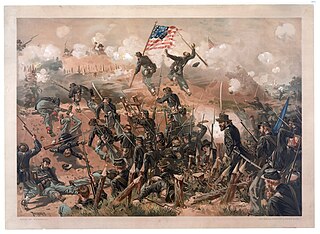
Bridgeport is a city in Jackson County, Alabama, United States. At the time of 2020 census the population was 2,264, down from 2,418 in 2010. Bridgeport is included in the Chattanooga-Cleveland-Dalton, TN-GA-AL Combined Statistical Area.

The Siege of Vicksburg was the final major military action in the Vicksburg campaign of the American Civil War. In a series of maneuvers, Union Major General Ulysses S. Grant and his Army of the Tennessee crossed the Mississippi River and drove the Confederate Army of Mississippi, led by Lieutenant General John C. Pemberton, into the defensive lines surrounding the fortress city of Vicksburg, Mississippi, leading to the successful siege and Confederate surrender.

An air burst or airburst is the detonation of an explosive device such as an anti-personnel artillery shell or a nuclear weapon in the air instead of on contact with the ground or target. The principal military advantage of an air burst over a ground burst is that the energy from the explosion is distributed more evenly over a wider area; however, the peak energy is lower at ground zero.
City Point was a town in Prince George County, Virginia, United States, that was annexed by the independent city of Hopewell in 1923. It served as headquarters of the Union Army during the siege of Petersburg during the American Civil War.
There have been many extremely large explosions, accidental and intentional, caused by modern high explosives, boiling liquid expanding vapour explosions (BLEVEs), older explosives such as gunpowder, volatile petroleum-based fuels such as gasoline, and other chemical reactions. This list contains the largest known examples, sorted by date. An unambiguous ranking in order of severity is not possible; a 1994 study by historian Jay White of 130 large explosions suggested that they need to be ranked by an overall effect of power, quantity, radius, loss of life and property destruction, but concluded that such rankings are difficult to assess.

Priddy's Hard is a former military installation in Gosport, England named for the original landowner and the firm beach found there. The site originated as a 1750s fort, and then became an armaments depot for Royal Navy and British Army weapons, explosives and other stores. The site was decommissioned in 1988, after over two hundred years of operation, with part now being developed for housing and an area retained as a museum.
Wilson's Raid was a cavalry operation through Alabama and Georgia in March–April 1865, late in the American Civil War. U.S. Brig. Gen. James H. Wilson led his U.S. Cavalry Corps to destroy Confederate manufacturing facilities and was opposed unsuccessfully by a much smaller force under Confederate Lt. Gen. Nathan Bedford Forrest.

Camp Shanks was a United States Army installation in the Orangetown, New York area. Named after Major General David C. Shanks, it was situated near the juncture of the Erie Railroad and the Hudson River. The camp was the largest U.S. Army embarkation camp used during World War II.

Fort Harker, located near Stevenson, Alabama, was a military fortification built by the Union Army during the American Civil War. Constructed in the summer of 1862 by soldiers and freed slaves of the Army of the Cumberland, the fort helped secure strategic railroad lines to ensure the free movement of Union troops and supplies in southeastern Tennessee and northeastern Alabama. Union General William Rosecrans established his headquarters at Fort Harker in July, 1863, from where he directed a successful campaign against the position of Confederate General Braxton Bragg in Chattanooga, Tennessee. The fort would be abandoned after the war and fall into disrepair. After restoration, the site became a city park in 1985.

Alabama was central to the Civil War, with the secession convention at Montgomery, the birthplace of the Confederacy, inviting other slaveholding states to form a southern republic, during January–March 1861, and to develop new state constitutions. The 1861 Alabaman constitution granted citizenship to current U.S. residents, but prohibited import duties (tariffs) on foreign goods, limited a standing military, and as a final issue, opposed emancipation by any nation, but urged protection of African-American slaves with trials by jury, and reserved the power to regulate or prohibit the African slave trade. The secession convention invited all slaveholding states to secede, but only 7 Cotton States of the Lower South formed the Confederacy with Alabama, while the majority of slave states were in the Union. Congress had voted to protect the institution of slavery by passing the Corwin Amendment on March 4, 1861, but it was never ratified.

The Alabama Drydock and Shipbuilding Company (ADDSCO) located in Mobile, Alabama, was one of the largest marine production facilities in the United States during the 20th century. It began operation in 1917, and expanded dramatically during World War II; with 30,000 workers, including numerous African Americans and women, it became the largest employer in the southern part of the state. During the defense buildup, which included other shipyards, Mobile became the second-largest city in the state, after Birmingham.

The city of Atlanta, Georgia, in Fulton County, was an important rail and commercial center during the American Civil War. Although relatively small in population, the city became a critical point of contention during the Atlanta Campaign in 1864 when a powerful Union Army approached from Union-held Tennessee. The fall of Atlanta was a critical point in the Civil War, giving the North more confidence, and leading to the re-election of President Abraham Lincoln and the eventual dissolution of the Confederacy. The capture of the "Gate City of the South" was especially important for Lincoln as he was in a contentious election campaign against the Democratic opponent George B. McClellan.

Mobile, Alabama, during the American Civil War was an important port city on the Gulf of Mexico for the Confederate States of America. Mobile fell to the Union Army late in the war following successful attacks on the defenses of Mobile Bay by the Union Navy.

A Royal Naval Armament Depot (RNAD) is an armament depot dedicated to supplying the Royal Navy. They were sister depots of Royal Naval Cordite Factories, Royal Naval Torpedo and Royal Naval Mine Depots. The only current RNAD is RNAD Coulport, which is the UK Strategic Weapon Facility for the nuclear-armed Trident Missile System; with many others being retained as tri-service 'Defence Munitions' sites.

This is a list of the National Register of Historic Places listings in Mobile, Alabama.
The 2019 Israeli airstrikes in Iraq began as unidentified drone or aircraft bombings of the Iranian-backed Popular Mobilization Forces (PMF) bases in Iraq starting on 19 July 2019. The strikes targeted Iranian proxy groups, based in Iraq, as well as IRGC operatives.

The Battle of Egypt Station was an engagement in Mississippi that took place during a successful Union cavalry raid during the American Civil War. A 3,500-man Union cavalry division under Brigadier General Benjamin Grierson defeated Confederate troops led by Franklin Gardner and Samuel J. Gholson. Grierson's raiding cavalry left Memphis, Tennessee on 21 December and first demolished a Confederate supply depot at Verona. Moving south while wrecking bridges and track along the Mobile and Ohio Railroad, the Union raiders encountered the Confederate defenders at Egypt Station. After their victory, Grierson's cavalry headed southwest to Vicksburg which it reached on January 5, 1865. The raiders destroyed a large amount of Confederate supplies and also damaged the Mississippi Central Railroad. Some of the men captured by Grierson's raiders proved to be former Union soldiers who volunteered to fight for the Confederacy rather than languish in prison camps. When John Bell Hood's army retreated into northern Mississippi after the Battle of Nashville, it was unable to obtain supplies because Grierson's raiders had damaged the railroad so badly.

There have been attacks in mainland Russia as a result of the Russian invasion of Ukraine, which began on 24 February 2022. The main targets have been the military, the arms industry and the oil industry. Many of the attacks have been drone strikes, firebombing, and rail sabotage. The Ukrainian intelligence services have acknowledged carrying out some of these attacks. Others have been carried out by anti-war activists in Russia. There has also been cross-border shelling, missile strikes and ground raids from Ukraine, mainly in the Belgorod, Kursk and Bryansk oblasts. Several times, Ukrainian-backed armed groups have launched incursions from Ukraine into Russia, captured border villages and battled the Russian military. While Ukraine has supported these ground incursions, it has denied direct involvement.
This timeline of the Russian invasion of Ukraine covers the period from 8 April 2022, when the area of heavy fighting shifted to the south and east of Ukraine, to 28 August 2022, the day before Ukraine announced the start of its Kherson counteroffensive.















